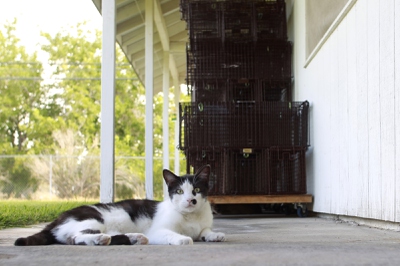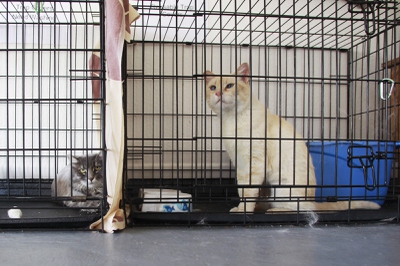
Smokey, a socialized cat who was found on the streets is seen in his cage in North Las Vegas Thursday, July 17, 2014.
Sunday, Oct. 19, 2014 | 2 a.m.
North Las Vegas soon could become the latest municipality in Southern Nevada to legalize feral cats.
Anita Wood, the city’s mayor pro tem, is working on an ordinance similar to ones already on the books in Las Vegas and Clark County. If it comes to fruition, feral cat colonies would be regulated as part of a larger effort to control the free-roaming feline population — and euthanize much less of it.
The plan is two-pronged. First, residents would be able to register as official cat colony caretakers and assume responsibility for the health and well-being of a large group of cats in a specific area. Second, local nonprofit groups would step in to vaccinate and sterilize feral cats.
The thinking is that neutering or spaying the cats would be a more effective — and humane — way to control their numbers than trying to remove or euthanize them.
“You have cats who are out there, they’re feral, you’ve got people obviously who are taking pity on them and feeding them, so the cats want to hang around — but no one’s really looking out for them,” Wood said.
She hopes to bring the ordinance before the City Council in November.
The ordinance would not bar North Las Vegas residents from going to Animal Control to have feral cats removed from their neighborhoods. It simply would give them another option.
If the ordinance goes into effect, a resident who calls the city with concerns about feral cats might be informed that one of his or her neighbors is taking care of the animals.
“A lot of times, someone sees cats running around, and they’re not happy about it,” said Keith Williams, director of the Community Cat Coalition of Clark County, or C5. “But if they understand that (the cats) are being managed, they’re being sterilized, that something is actually being done with them, then they’re good with that.”
In addition to his duties at C5 — which traps, neuters and returns feral cats to their environments — Williams also volunteers as the central sponsor for colonies in Las Vegas and Clark County, overseeing the registration of local colonies and serving as the point person for caretakers.
Because of his dual responsibilities, Williams has had a lot of exposure to sanctioned colonies in Las Vegas and unincorporated Clark County. He said there are 494 registered colonies in the unincorporated county and 277 in Las Vegas, with the average colony consisting of 11 cats.
Feral cats set up camp together because they’re still inclined to be social, Williams said. A feral cat isn’t a breed but rather a term describing a domestic cat that is living independently from humans.
They tend to congregate around resources that can sustain them — food, water, shelter — and in older neighborhoods where colonies have had time to breed, Williams said.
In North Las Vegas, Williams estimated feral cats number around 20,000 to 30,000. Countywide, he put the number between 200,000 and 300,000.
The ordinance would allow people who already are aware of the cats to step forward.
“There are residents who don’t want to report that because if they do, they know that Animal Control will come out and they’ll be picked up and possibly euthanized,” Wood said. “I don’t know if anyone feels good about that.”
If the North Las Vegas ordinance is passed, Henderson would be the only municipality in the valley without similar legislation. And it probably will remain that way.
Henderson spokeswoman Kathleen Richards said the city requires all pets to be kept on leashes. If someone finds an animal without one, the city takes it to the Henderson Animal Care and Control Facility, which keeps it for three working days for an owner to retrieve.
After that, the animal becomes city property. Henderson officials spay or neuter and vaccinate it if necessary, then give it behavioral tests. Passing means the animal can be put up for adoption; failure means it could be euthanized.
Additionally, Henderson requires all dogs and cats older than 4 months to be spayed or neutered. Other parts of the valley, including North Las Vegas, have similar requirements.
By Williams’ measures, Las Vegas and Clark County have seen success with their ordinances. He said most colonies report few kittens, if any, and new cats are sterilized.
While new arrivals usually prevent colonies from dwindling to zero, some have disappeared completely. Others grow smaller over time: One large colony Williams has tracked shrunk from 56 cats in 2009 to about 15 today.
Another important metric Williams looks at is the number of cats euthanized by the Lied Shelter run by the Animal Foundation, because he said many people take kittens born to free-roaming cats there.
The number of cats euthanized monthly dropped from about 2,260 in May 2009 to about 900 in May of this year. Feral cats accounted for 320 and 223 of the totals, respectively, according to the foundation.
Euthanized cats from North Las Vegas numbered 311 in May 2009 and dropped to 157 in May 2014. Those numbers include non-feral euthanizations.
“We’re making great progress,” Williams said. “But we still have a ways to go.”



Join the Discussion:
Check this out for a full explanation of our conversion to the LiveFyre commenting system and instructions on how to sign up for an account.
Full comments policy